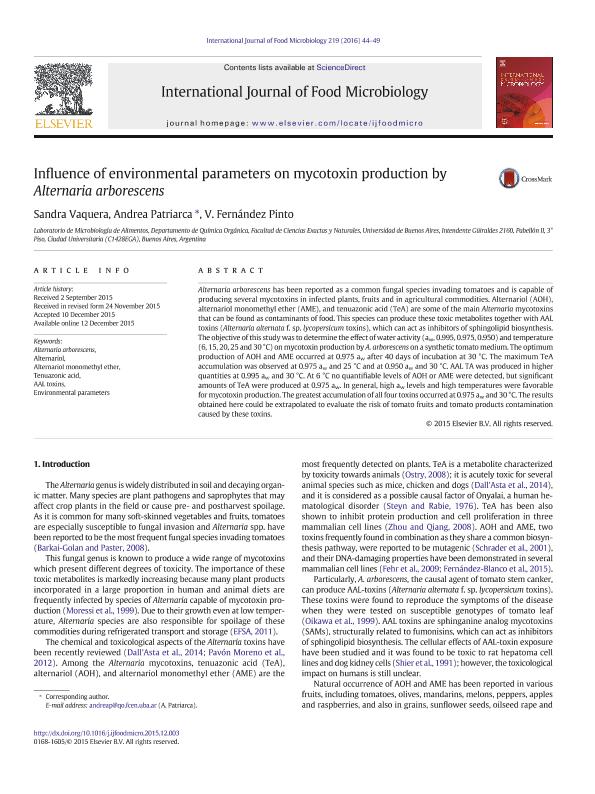Mostrar el registro sencillo del ítem
dc.contributor.author
Vaquera, Sandra Lucrecia

dc.contributor.author
Patriarca, Andrea Rosana

dc.contributor.author
Fernández Pinto, Virginia

dc.date.available
2017-09-12T17:32:41Z
dc.date.issued
2015-12-12
dc.identifier.citation
Vaquera, Sandra Lucrecia; Patriarca, Andrea Rosana; Fernández Pinto, Virginia; Influence of environmental parameters on mycotoxin production by Alternaria arborescens; Elsevier Science; International Journal of Food Microbiology; 219; 12-12-2015; 44-49
dc.identifier.issn
0168-1605
dc.identifier.uri
http://hdl.handle.net/11336/24018
dc.description.abstract
Alternaria arborescens has been reported as a common fungal species invading tomatoes and is capable of producing several mycotoxins in infected plants, fruits and in agricultural commodities. Alternariol (AOH), alternariol monomethyl ether (AME), and tenuazonic acid (TeA) are some of the main Alternaria mycotoxins that can be found as contaminants of food. This species can produce these toxic metabolites together with AAL toxins (Alternaria alternata f. sp. lycopersicum toxins), which can act as inhibitors of sphingolipid biosynthesis. The objective of this study was to determine the effect of water activity (aw, 0.995, 0.975, 0.950) and temperature (6, 15, 20, 25 and 30 °C) on mycotoxin production by A. arborescens on a synthetic tomato medium. The optimum production of AOH and AME occurred at 0.975 aw after 40 days of incubation at 30 °C. The maximum TeA accumulation was observed at 0.975 aw and 25 °C and at 0.950 aw and 30 °C. AAL TA was produced in higher quantities at 0.995 aw and 30 °C. At 6 °C no quantifiable levels of AOH or AME were detected, but significant amounts of TeA were produced at 0.975 aw. In general, high aw levels and high temperatures were favorable for mycotoxin production. The greatest accumulation of all four toxins occurred at 0.975 aw and 30 °C. The results obtained here could be extrapolated to evaluate the risk of tomato fruits and tomato products contamination caused by these toxins.
dc.format
application/pdf
dc.language.iso
eng
dc.publisher
Elsevier Science

dc.rights
info:eu-repo/semantics/openAccess
dc.rights.uri
https://creativecommons.org/licenses/by-nc-sa/2.5/ar/
dc.subject
Alternaria Arborescens
dc.subject
Alternariol
dc.subject
Alternariol Monomethyl Ether
dc.subject
Tenuazonic Acid
dc.subject
Aal Toxins
dc.subject
Environmental Parameters
dc.subject.classification
Alimentos y Bebidas

dc.subject.classification
Otras Ingenierías y Tecnologías

dc.subject.classification
INGENIERÍAS Y TECNOLOGÍAS

dc.title
Influence of environmental parameters on mycotoxin production by Alternaria arborescens
dc.type
info:eu-repo/semantics/article
dc.type
info:ar-repo/semantics/artículo
dc.type
info:eu-repo/semantics/publishedVersion
dc.date.updated
2017-08-07T18:41:41Z
dc.identifier.eissn
1879-3460
dc.journal.volume
219
dc.journal.pagination
44-49
dc.journal.pais
Países Bajos

dc.journal.ciudad
Amsterdam
dc.description.fil
Fil: Vaquera, Sandra Lucrecia. Universidad de Buenos Aires. Facultad de Ciencias Exactas y Naturales. Departamento de Química Orgánica; Argentina. Consejo Nacional de Investigaciones Científicas y Técnicas; Argentina
dc.description.fil
Fil: Patriarca, Andrea Rosana. Consejo Nacional de Investigaciones Científicas y Técnicas. Oficina de Coordinación Administrativa Ciudad Universitaria. Instituto de Micología y Botánica. Universidad de Buenos Aires. Facultad de Ciencias Exactas y Naturales. Instituto de Micología y Botánica; Argentina
dc.description.fil
Fil: Fernández Pinto, Virginia. Universidad de Buenos Aires. Facultad de Ciencias Exactas y Naturales. Departamento de Química Orgánica; Argentina. Consejo Nacional de Investigaciones Científicas y Técnicas; Argentina
dc.journal.title
International Journal of Food Microbiology

dc.relation.alternativeid
info:eu-repo/semantics/altIdentifier/url/http://www.sciencedirect.com/science/article/pii/S0168160515301835
dc.relation.alternativeid
info:eu-repo/semantics/altIdentifier/doi/http://dx.doi.org/10.1016/j.ijfoodmicro.2015.12.003
Archivos asociados
